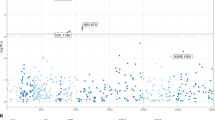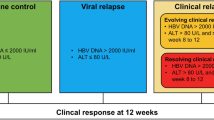Abstract
Histone deacetylases (HDACs) influence many cellular processes, including the modulation of signal transducer and activator of transcription activity (STAT) in response to interferon (IFN). To identify genetic markers that help optimize the IL-28B prediction of chronic hepatitis C (CHC) sustained virological response (SVR), we evaluated 27 single-nucleotide polymorphisms (SNPs) in HDAC1–11. Three SNPs, rs3778216, rs976552 and rs368328 in HDAC2, HDAC3 and HDAC5, respectively, were independently associated with SVR (P<0.05). The addition of these three HDAC’s SNPs to the IL-28B predictive model (area under the curve (AUC)=0.630) rendered an important improvement of AUC-receiver operating characteristic value (AUC=0.747, P=0.021). Chi-squared Automatic Interaction Detector (CHAID) analysis denoted the significance of the rs3778216 C/C genotype in identifying a group of good responders despite carrying IL-28B T allele (79.2% of SVR), whereas HDAC5 G allele characterized a subgroup with poor response rate (25.5%). However, HDAC3 rs976552 did not display a relevant role for the hierarchical classification of patients. Variables related to SVR in hepatitis C virus genotype 1 (HCV-1) cohort were the same of those obtained for the overall population. Interestingly, in non-HCV-1 patients (n=56) the HDAC2 C/C genotype was the unique predictive variable related to SVR (AUC=0.733, P<0.007). Thus, these preliminary results suggest the potential usefulness of combined IL-28B and HDAC genotyping for the CHC patients’ classification by likelihood of an SVR.
This is a preview of subscription content, access via your institution
Access options
Subscribe to this journal
Receive 6 digital issues and online access to articles
$119.00 per year
only $19.83 per issue
Buy this article
- Purchase on Springer Link
- Instant access to full article PDF
Prices may be subject to local taxes which are calculated during checkout



Similar content being viewed by others
References
Shepard CW, Finelli L, Alter MJ . Global epidemiology of hepatitis C virus infection. Lancet Infect Dis 2005; 5: 558–567.
Hofmann WP, Zeuzem S . A new standard of care for the treatment of chronic HCV infection. Nat Rev Gastroenterol Hepatol 2011; 8: 257–264.
Siebert U, Sroczynski G, Rossol S, Wasem J, Ravens-Sieberer U, Kurth BM et al. Cost effectiveness of peginterferon alpha-2b plus ribavirin versus interferon alpha-2b plus ribavirin for initial treatment of chronic hepatitis C. Gut 2003; 52: 425–432.
de Rueda PM, Lopez-Nevot MA, Saenz-Lopez P, Casado J, Martin-Casares A, Palomares P et al. Importance of host genetic factors HLA and IL28B as predictors of response to pegylated Interferon and ribavirin. Am J Gastroenterol 2011; 106: 1246–1254.
Ge D, Fellay J, Thompson AJ, Simon JS, Shianna KV, Urban TJ et al. Genetic variation in IL28B predicts hepatitis C treatment-induced viral clearance. Nature 2009; 461: 399–401.
Lopez-Rodriguez R, Trapero-Marugan M, Borque MJ, Roman M, Hernandez-Bartolome A, Rodriguez-Munoz Y et al. Genetic variants of interferon-stimulated genes and IL-28B as host prognostic factors of response to combination treatment for chronic hepatitis C. Clin Pharmacol Ther 2011; 90: 712–721.
Suppiah V, Gaudieri S, Armstrong NJ, O’Connor KS, Berg T, Weltman M et al. IL28B, HLA-C, and KIR variants additively predict response to therapy in chronic hepatitis C virus infection in a European Cohort: a cross-sectional study. PLoS Med 2011; 8: e1001092.
Zaidi SK, Young DW, Montecino M, van Wijnen AJ, Stein JL, Lian JB et al. Bookmarking the genome: maintenance of epigenetic information. J Biol Chem 2011; 286: 18355–18361.
Haberland M, Montgomery RL, Olson EN . The many roles of histone deacetylases in development and physiology: implications for disease and therapy. Nat Rev Genet 2009; 10: 32–42.
Peserico A, Simone C . Physical and functional HAT/HDAC interplay regulates protein acetylation balance. J Biomed Biotechnol 2011; 2011: 371832.
Choudhary C, Kumar C, Gnad F, Nielsen ML, Rehman M, Walther TC et al. Lysine acetylation targets protein complexes and co-regulates major cellular functions. Science 2009; 325: 834–840.
Spange S, Wagner T, Heinzel T, Kramer OH . Acetylation of non-histone proteins modulates cellular signalling at multiple levels. Int J Biochem Cell Biol 2009; 41: 185–198.
Chang HM, Paulson M, Holko M, Rice CM, Williams BR, Marie I et al. Induction of interferon-stimulated gene expression and antiviral responses require protein deacetylase activity. Proc Natl Acad Sci USA 2004; 101: 9578–9583.
Icardi L, Lievens S, Mori R, Piessevaux J, De Cauwer L, De Bosscher K et al. Opposed regulation of type I IFN-induced STAT3 and ISGF3 transcriptional activities by histone deacetylases (HDACS) 1 and 2. FASEB J 2012; 26: 240–249.
Kadota S, Nagata K . Pp32, an INHAT component, is a transcription machinery recruiter for maximal induction of IFN-stimulated genes. J Cell Sci 2011; 124 (Part 6): 892–899.
Lachenmayer A, Toffanin S, Cabellos L, Alsinet C, Hoshida Y, Villanueva A et al. Combination therapy for hepatocellular carcinoma: additive preclinical efficacy of the HDAC inhibitor panobinostat with sorafenib. J Hepatol 2012; 56: 1343–1350.
Quint K, Agaimy A, Di Fazio P, Montalbano R, Steindorf C, Jung R et al. Clinical significance of histone deacetylases 1, 2, 3, and 7: HDAC2 is an independent predictor of survival in HCC. Virchows Arch 2011; 459: 129–139.
Rikimaru T, Taketomi A, Yamashita Y, Shirabe K, Hamatsu T, Shimada M et al. Clinical significance of histone deacetylase 1 expression in patients with hepatocellular carcinoma. Oncology 2007; 72: 69–74.
Yang Z, Zhou L, Wu LM, Xie HY, Zhang F, Zheng SS . Combination of polymorphisms within the HDAC1 and HDAC3 gene predict tumor recurrence in hepatocellular carcinoma patients that have undergone transplant therapy. Clin Chem Lab Med 2010; 48: 1785–1791.
Spiegel S, Milstien S, Grant S . Endogenous modulators and pharmacological inhibitors of histone deacetylases in cancer therapy. Oncogene 2011; 31: 537–551.
Witthoeft T, Hueppe D, John C, Goelz J, Heyne R, Moeller B et al. Efficacy and tolerability of peginterferon alfa-2a or alfa-2b plus ribavirin in the daily routine treatment of patients with chronic hepatitis C in Germany: the PRACTICE study. J Viral Hepat 2010; 17: 459–468.
Adcock IM . HDAC inhibitors as anti-inflammatory agents. Br J Pharmacol 2007; 150: 829–831.
Nusinzon I, Horvath CM . Interferon-stimulated transcription and innate antiviral immunity require deacetylase activity and histone deacetylase 1. Proc Natl Acad Sci USA 2003; 100: 14742–14747.
Nusinzon I, Horvath CM . Positive and negative regulation of the innate antiviral response and beta interferon gene expression by deacetylation. Mol Cell Biol 2006; 26: 3106–3113.
Shakespear MR, Halili MA, Irvine KM, Fairlie DP, Sweet MJ . Histone deacetylases as regulators of inflammation and immunity. Trends Immunol 2011; 32: 335–343.
Kramer OH, Heinzel T . Phosphorylation-acetylation switch in the regulation of STAT1 signaling. Mol Cell Endocrinol 2011; 315: 40–48.
Kramer OH, Knauer SK, Greiner G, Jandt E, Reichardt S, Guhrs KH et al. A phosphorylation-acetylation switch regulates STAT1 signaling. Genes Dev 2009; 23: 223–235.
Knutson SK, Chyla BJ, Amann JM, Bhaskara S, Huppert SS, Hiebert SW . Liver-specific deletion of histone deacetylase 3 disrupts metabolic transcriptional networks. EMBO J 2008; 27: 1017–1028.
Holden M, Deng S, Wojnowski L, Kulle B . GSEA-SNP: applying gene set enrichment analysis to SNP data from genome-wide association studies. Bioinformatics 2008; 24: 2784–2785.
Lindh M, Lagging M, Farkkila M, Langeland N, Morch K, Nilsson S et al. Interleukin 28B gene variation at rs12979860 determines early viral kinetics during treatment in patients carrying genotypes 2 or 3 of hepatitis C virus. J Infect Dis 2011; 203: 1748–1752.
Scherzer TM, Hofer H, Staettermayer AF, Rutter K, Beinhardt S, Steindl-Munda P et al. Early virologic response and IL28B polymorphisms in patients with chronic hepatitis C genotype 3 treated with peginterferon alfa-2a and ribavirin. J Hepatol 2011; 54: 866–871.
Chen Y, Xu HX, Wang LJ, Liu XX, Mahato RI, Zhao YR . Meta-analysis: IL28B polymorphisms predict sustained viral response in HCV patients treated with pegylated interferon-alpha and ribavirin. Aliment Pharmacol Ther 2012; 36: 91–103.
Schreiber J, Moreno C, Garcia BG, Louvet A, Trepo E, Henrion J et al. Meta-analysis: the impact of IL28B polymorphisms on rapid and sustained virological response in HCV-2 and -3 patients. Aliment Pharmacol Ther 2012; 36: 353–362.
Sole X, Guino E, Valls J, Iniesta R, Moreno V . SNPStats: a web tool for the analysis of association studies. Bioinformatics 2006; 22: 1928–1929.
Acknowledgements
We are grateful to the team of Gastroenterology Services, Hospital Universitario de la Princesa, Hospital Universitario San Cecilio and Hospital Universitario Central de Asturias. We thank all patients for their generous cooperation. We also thank IIS Princesa, which provided statistical assistance (Unidad de Apoyo Metodológico, Francisco Rodriguez and Lorena Vega). This work was partially supported by the Ministerio de Ciencia e Innovación (SAF: 2010/21805), Fundación Mutua Madrileña to Paloma Sanz-Cameno and Ricardo Moreno-Otero, and CIBERehd (Instituto de Salud Carlos III, Madrid). Paloma Sanz-Cameno has a grant of Asociación Española Contra el Cáncer (AIO 2010, AECC).
Author information
Authors and Affiliations
Corresponding author
Ethics declarations
Competing interests
The authors declare no conflict of interest.
Additional information
Supplementary Information accompanies this paper on Genes and Immunity website
Supplementary information
Rights and permissions
About this article
Cite this article
López-Rodríguez, R., Hernández-Bartolomé, Á., Borque, M. et al. Polymorphisms in histone deacetylases improve the predictive value of IL-28B for chronic hepatitis C therapy. Genes Immun 14, 317–324 (2013). https://doi.org/10.1038/gene.2013.24
Received:
Revised:
Accepted:
Published:
Issue Date:
DOI: https://doi.org/10.1038/gene.2013.24
Keywords
This article is cited by
-
DNA methylation profiling identifies novel markers of progression in hepatitis B-related chronic liver disease
Clinical Epigenetics (2016)



